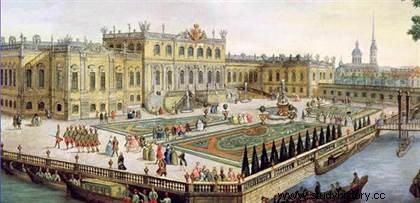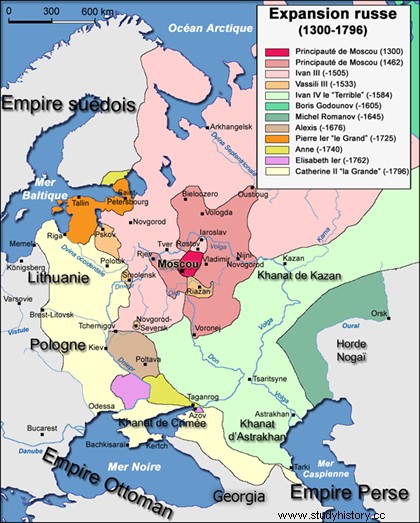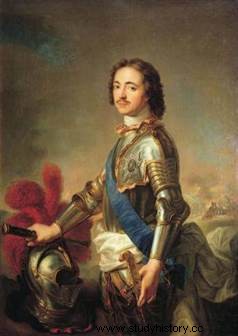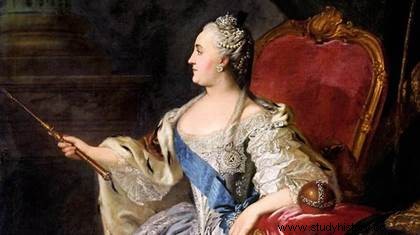 Led by the Romanovs, the Russian Empire developed from Peter I:throughout the 18th and 19th centuries, it expanded to the west towards the Baltic States, Poland and the Balkans, as well as to the south (Caucasus, Central Asia) and east (Siberia). Originally (1240 to 1480), the Russian principalities were subject to the Mongol Tatars. The Grand Prince of Moscow Ivan III undertook upon his accession to the throne in 1462 to unify them under his aegis and to begin the territorial expansion of Russia. Compared to the rest of Western Europe, it remains weak and backward. It was Peter the Great who, at the end of the 17th century, shaped Modern Imperial Russia and it was under Catherine II and Alexander I that the Russian Empire will reach its peak.
Led by the Romanovs, the Russian Empire developed from Peter I:throughout the 18th and 19th centuries, it expanded to the west towards the Baltic States, Poland and the Balkans, as well as to the south (Caucasus, Central Asia) and east (Siberia). Originally (1240 to 1480), the Russian principalities were subject to the Mongol Tatars. The Grand Prince of Moscow Ivan III undertook upon his accession to the throne in 1462 to unify them under his aegis and to begin the territorial expansion of Russia. Compared to the rest of Western Europe, it remains weak and backward. It was Peter the Great who, at the end of the 17th century, shaped Modern Imperial Russia and it was under Catherine II and Alexander I that the Russian Empire will reach its peak.
From Third Rome to the expansion of Russia
During the centuries of Tatar suzerainty, Moscow remained oriented towards the east, Persia and Central Asia. Moreover, the Russians were linked to the Byzantine Empire by the Orthodox faith. After the fall of Constantinople, conquered by the Ottomans in 1453, Moscow was elevated to the rank of third Rome. By marrying Zoe, niece of the last Byzantine emperor, Grand Prince Ivan III adopted the emblem of the Byzantine Empire, the double-headed eagle.
Ivan IV (1533 to 1584) confirmed this association by having himself crowned Tsar (derived from “caesar”, or emperor) in 1547. Upon his death, the area of Russian territory had almost doubled. He overcame the Tatars and extended the Russian sphere of influence to Siberia. However, his attempts to expand west of the Baltic met with resistance from Sweden and Poland. Ivan IV restricted the power of the nobles (the boyars) and seized their lands. He instituted the Reign of Terror, during which his personal guards killed thousands of boyars, earning him the nickname Ivan the Terrible.
 Between 1604 and 1613, the “Time of Troubles” was characterized by a civil war that ravaged much of western Russia. The conflicts ended with the accession to the throne of the Romanovs, a dynasty that reigned until 1917. The population continued to swarm eastward, along the rivers of Siberia. In 1637, the Russians reached the Pacific coast. They established trading posts, making furs the country's most lucrative export. Its vastness, however, did not always work in its favor Rich in natural resources, Russia suffered from a shortage of manpower, as well as communication and transport problems.
Between 1604 and 1613, the “Time of Troubles” was characterized by a civil war that ravaged much of western Russia. The conflicts ended with the accession to the throne of the Romanovs, a dynasty that reigned until 1917. The population continued to swarm eastward, along the rivers of Siberia. In 1637, the Russians reached the Pacific coast. They established trading posts, making furs the country's most lucrative export. Its vastness, however, did not always work in its favor Rich in natural resources, Russia suffered from a shortage of manpower, as well as communication and transport problems.
To remedy the first of these obstacles, serfdom was instituted:the peasants found themselves bound for life to the same lord in conditions close to slavery. The nobles, for their part, became the serfs of the tsars. During the 16th century, commercial and cultural exchanges with Europe grew, resulting in the establishment in Moscow of a prosperous community of Westerners made up of merchants, craftsmen, artists, intellectuals and members of the clergy.
Peter the Great's Russia opens up to the West
 The reign of Peter the Great (1682-1725) marked a turning point in Russian history. Admittedly, his three predecessors had already introduced reforms aimed at westernizing the Empire, but Peter the Great, for his part, tried to elevate it to the rank of modern European power. In 1697 and 1698, he visited Prussia, the Netherlands, England and Austria to learn about Western technologies, particularly in shipbuilding.
The reign of Peter the Great (1682-1725) marked a turning point in Russian history. Admittedly, his three predecessors had already introduced reforms aimed at westernizing the Empire, but Peter the Great, for his part, tried to elevate it to the rank of modern European power. In 1697 and 1698, he visited Prussia, the Netherlands, England and Austria to learn about Western technologies, particularly in shipbuilding.
Returning to his homeland, he reorganized the army. Then, in 1700, he went to war against Sweden in order to wrest from it an outlet on the Baltic, where he founded his new capital, Saint Petersburg. In the Urals, Peter the Great established iron and copper foundries in order to exploit the rich ore deposits of the region. He went so far as to modify the dress of his subjects by ordering his courtiers to dress in Western style and the nobles to shave the traditional Russian beard. Anyone who refused to do so had to pay a fine.
Under his reign, the serfs were imposed more constraints, including the taxes necessary to finance his great projects. In addition, many of them were forcibly conscripted into the construction of Saint Petersburg, where thousands perished in atrocious conditions. Peter the Great went so far as to extend serfdom to the workers of his new factories.
The Russian Empire in the 18th century
During the 18th century, Russia experienced a slow expansion. The Ottomans had to cede Crimea and southern Ukraine; Sevastopol fell in 1783, opening the Black Sea to Russian traders. To the east, Siberian fur traders crossed the Bering Strait into North America to; in 1784, founded the first European colonies in Alaska. However, it was in the west that Russia annexed the largest territory. Indeed, taking advantage of the weakening of Poland, it took part, with Austria and Prussia, in its partition between 1772 and 1795. Then, at the end of the Napoleonic wars (see pages 146-149), the Congress of Vienna (1815) ceded the rest of the kingdom to Russia.
 Many of these achievements were added to the empire during the reign of Catherine II the Great, sovereign of German origin. Ascended to the throne in 1762, on the death of her husband Peter III, grandson of Peter the Great, she governed until 1796. Reigning as an absolute monarch, she was also passionate about the artistic currents of the time, both in the field of painting, than in that of architecture or music. His gallery of paintings is the origin of the national collection currently on display in the Hermitage Museum, Saint Petersburg. At his invitation, many Germans settled in Russia, especially in the newly conquered regions north of the Black Sea, where they introduced productive farming methods.
Many of these achievements were added to the empire during the reign of Catherine II the Great, sovereign of German origin. Ascended to the throne in 1762, on the death of her husband Peter III, grandson of Peter the Great, she governed until 1796. Reigning as an absolute monarch, she was also passionate about the artistic currents of the time, both in the field of painting, than in that of architecture or music. His gallery of paintings is the origin of the national collection currently on display in the Hermitage Museum, Saint Petersburg. At his invitation, many Germans settled in Russia, especially in the newly conquered regions north of the Black Sea, where they introduced productive farming methods.
Like other sovereigns of Europe, it was with concern that Catherine II witnessed the outbreak of the Revolution of 1789 in France. As the revolutionaries worked to spread their ideas across Europe, Russia allied with Austria, Spain, Prussia and Britain to declare war on France. In 1796, Paul, son of Catherine succeeded him on the throne. The eccentric initiatives of the latter, who for example sent a regiment of Cossacks to conquer India, earned him assassination in 1801. His son Alexander I succeeded him and seized Finland at the expense of Sweden .
In 1812, Napoleon invaded Russia, the vastness of which would be fatal to him. The French army on the verge of annihilation had to retreat, pursued throughout Europe by Tsar Alexander and the allies. In 1814, he entered Paris, establishing Russia's place among the greats of Europe.
Bibliography
- History of Russia and its Empire, by Michel Heller. Tempus, 2015.
- History of Russia:From Ivan the Terrible to Nicolas II - 1547-1917, by Pierre Gonneau. Tallandier, 2016.
